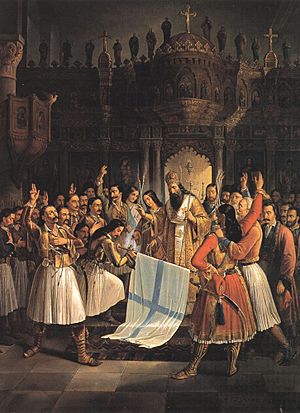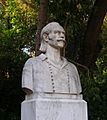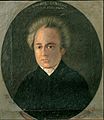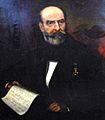Greek War of Independence facts for kids
Quick facts for kids Greek War of Independence |
|||||||
|---|---|---|---|---|---|---|---|
| Part of Wars of Independence | |||||||
 Germanos blessing the flag at Agia Lavra. Oil painting, 1865. |
|||||||
|
|||||||
| Belligerents | |||||||
| Commanders and leaders | |||||||
The Greek War of Independence (1821–1829) was a big fight for freedom. It is also called the Greek Revolution. Greeks fought to become independent from the Ottoman Empire. This empire had ruled Greece for many centuries.
The Ottoman Empire was very powerful. It controlled a large area, including Greece. The Greeks wanted their own country back. They dreamed of being free again.
The fight for independence was long and hard. It lasted for eight years. Many brave Greeks fought for their freedom. They were called revolutionaries.
Other countries helped the Greeks. Muhammad Ali Pasha of Egypt sent his son, Ibrahim Pasha, to help the Ottomans. But European Christian countries supported the Greeks. The United Kingdom, France, and Russia sent their navies.
A very important battle happened at Navarino. The European fleets destroyed the Ottoman-Egyptian fleet. This was a major turning point. It helped the Greeks win their independence.
Finally, in 1832, Greece became an independent country. This was confirmed by the Treaty of Constantinople. Greece was the first nation to break free from the Ottoman Empire.
The Road to Freedom
For centuries, Greece was part of the Ottoman Empire. The Ottomans were Muslim rulers. Most Greeks were Christian. This difference in religion was one reason for tension.
Many Greeks felt proud of their ancient history. They remembered the glory of ancient Greece. They wanted to bring back their own culture and language. They wanted to rule themselves.
Secret Societies and Ideas
Before the war, secret groups formed. One important group was the Filiki Eteria (Friendly Society). It was started in 1814. Its goal was to free Greece.
Members of this society met in secret. They planned the revolution. They gathered support from Greeks everywhere. They also got help from Greeks living in other countries.
Important thinkers also inspired the Greeks. Rigas Feraios wrote patriotic songs. He encouraged Greeks to fight for liberty. These ideas spread across Greece.
Early Uprisings
The revolution officially began in 1821. It started in different places. One leader was Alexander Ypsilantis. He led an uprising in the Danubian Principalities. This was outside Greece, but it sparked hope.
In Greece itself, the revolution began in the Peloponnese. This is a large peninsula in southern Greece. Many local leaders joined the fight. They raised flags of rebellion.
Key Leaders and Heroes
Many heroes emerged during the war. Theodoros Kolokotronis was a famous military leader. He was known for his clever tactics. He led many victories against the Ottomans.
Georgios Karaiskakis was another brave general. He fought in central Greece. He was known for his courage and leadership.
On the sea, Konstantinos Kanaris was a hero. He was a skilled naval commander. He led daring attacks against Ottoman ships.
Laskarina Bouboulina was a rare female naval commander. She used her own money to build ships. She fought bravely in many battles.
Major Battles and Events
The war was full of fierce battles. The Greeks faced a much larger army. But they fought with great determination.
The Siege of Tripolitsa
One important early victory was the Siege of Tripolitsa. This was a major Ottoman stronghold. It was located in the Peloponnese.
Greek forces surrounded the city. They fought for many weeks. In September 1821, the Greeks captured Tripolitsa. This was a huge boost for their cause.
Ottoman Counterattacks
The Ottoman Empire did not give up easily. They sent large armies to crush the rebellion. They tried to take back areas the Greeks had won.
One famous Ottoman general was Mahmud Dramali Pasha. He led a large army into the Peloponnese. But the Greeks, led by Kolokotronis, defeated him.
The Role of Egypt
The Ottoman Sultan asked for help. He turned to Muhammad Ali Pasha of Egypt. Egypt had a strong army and navy.
Muhammad Ali sent his son, Ibrahim Pasha, to Greece. Ibrahim Pasha's army was well-trained. They caused many problems for the Greeks.
Ibrahim Pasha's forces recaptured many areas. They were very strong. The Greeks struggled against them.
The Siege of Missolonghi
The town of Missolonghi was very important. It was a symbol of Greek resistance. The Ottomans besieged it twice.
The first siege was in 1822. The Greeks successfully defended it. The second siege was much longer and harder. It lasted for almost a year (1825-1826).
Many Greeks died defending Missolonghi. They ran out of food and supplies. Finally, the remaining defenders tried to break out. Many were killed. This event shocked Europe.
European Intervention
The struggle in Greece caught the attention of Europe. Many people felt sympathy for the Greeks. They saw it as a fight for freedom.
Famous writers and artists supported the Greeks. One famous supporter was the English poet Lord Byron. He even went to Greece to help. He died there in 1824.
The major European powers decided to act. The United Kingdom, France, and Russia formed an alliance. They wanted to help Greece gain independence.
The most important battle was the Battle of Navarino. It happened on October 20, 1827. It was a naval battle.
The combined European fleet faced the Ottoman-Egyptian fleet. The battle was fierce. The European ships were more powerful.
The European fleet destroyed most of the Ottoman-Egyptian ships. This was a massive defeat for the Ottomans. It greatly weakened their power in the region.
This battle was a turning point. It made it clear that Greece would become independent. The Ottomans could no longer stop the revolution.
After the War
After the Battle of Navarino, the war continued for a while. But the outcome was clear. The Ottoman Empire had lost.
In 1828, a Greek state was formed. It was called the First Hellenic Republic. Ioannis Kapodistrias became its first governor.
Treaty of Constantinople
The independence of Greece was officially recognized. This happened with the Treaty of Constantinople in July 1832. This treaty set the borders of the new Greek state.
The new country was called the Kingdom of Greece. It was a small country at first. But it was free.
Legacy of the Revolution
The Greek War of Independence was very important. It showed that a small nation could fight for freedom. It inspired other groups to seek independence.
Today, Greeks celebrate their independence every year. March 25th is a national holiday. It marks the start of the revolution.
The national anthem of Greece is the Hymn to Liberty. It was written by Dionysios Solomos. It celebrates the bravery of the Greek fighters.
The revolution created a new, independent Greece. It was a proud moment for the Greek people. It showed the power of fighting for what you believe in.
Images for kids
-
Portrait of a Greek armatolos by Richard Parkes Bonington (oil painting, 1825–1826, Benaki Museum)
-
Adamantios Korais was an important Greek scholar.
-
House of Filiki Eteria in Odesa, where the secret society was founded.
-
Alexander Ypsilantis crosses the Pruth, by Peter von Hess.
-
Declaration of the revolutionaries of Patras.
-
Statue of Theodoros Kolokotronis in Nafplio.
-
Jean-Pierre Boyer, President of Haiti. Haiti was the first state to recognise Greek independence.
-
The Reception of Lord Byron at Missolonghi by Theodoros Vryzakis.
-
Letter of Alexander Ypsilantis to Emmanouel Pappas.
-
Bust of Emmanouel Pappas in Athens.
-
Konstantinos Kanaris during the Revolution.
-
"The burning of the Ottoman frigate at Eressos by Dimitrios Papanikolis" by Konstantinos Volanakis.
-
Dionysios Solomos wrote the Hymn to Liberty, the Greek national anthem.
-
"The burning of the Turkish flagship by Kanaris" by Nikiforos Lytras.
-
The sortie of Missolonghi by Theodoros Vryzakis.
-
"Karaiskakis landing at Phaliro" by Konstantinos Volanakis.
-
Portrait of Muhammad Ali Pasha by Auguste Couder.
-
The Naval Battle of Navarino by Ambroise Louis Garneray.
-
General Maison meeting Ibrahim Pasha in Navarino in September 1828 by Jean-Charles Langlois.
-
Map showing the original territory of the Kingdom of Greece as laid down in the Treaty of 1832 (in dark blue).
-
"Grateful Hellas" by Theodoros Vryzakis.
-
Nikolaos Mantzaros composed the music for Hymn to Liberty.
See also
 In Spanish: Guerra de independencia de Grecia para niños
In Spanish: Guerra de independencia de Grecia para niños






































